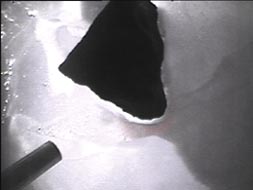
 |
Program News
|
New Meteorites
Marilyn Lindstrom
This newsletter contains something for everyone! It lists classifications of about 440 meteorites mostly from the 1997 and 1998 ANSMET seasons. It also gives descriptions of about 45 meteorites of special petrologic type. These include 1 iron, 17 chondrites (7 CC, 1 EC, 9 OC) and 27 achondrites (25 HED, UR). Most notable are an acapulcoite (GRA98028) and an olivine diogenite (GRA98108).
JSC Renovations
Marilyn Lindstrom
After many complaints of water leaks in offices, a new roof was recently installed on the Planetary Science building at JSC. This six month procedure had a significant impact on activities in the Meteorite Processing Lab which is on the top floor of that building. The potential for contamination by dust, asbestos, or tar fumes caused us to monitor air quality on a daily basis. We refrained from allocations processing during that time and shut down initial processing of small ordinary chondrites whenever particle counts were above our class 10,000 limit. Since completion, we have cleaned the lab and are beginning allocations from the Fall 1999 MWG meeting. We apologize for delays caused by the renovations, but felt it better to be clean and safe than sorry for contamination.
ANSMET Field Season Report
Ralph Harvey
The 1999-2000 ANSMET field season is complete (mostly) as of this writing. The field party (including Henning Haack, Phil Bland, Peter Pesch, Kevin Righter, Rene Martinez, Andreas Weigel, John Schutt and Ralph Harvey) was put-in at Beardmore South Camp on Dec. 1 and traversed to the Foggy Bottom region (home of the majority of QUE meteorites) the next day. Searching systematically in the icefields to the north of Foggy Bottom (the Mare Meteoriticus and Tail’s End icefields), and in the icefields surrounding nearby Goodwin Nunataks, the main party recovered 915 specimens. A party of two separated from the main group on Dec. 8 to conduct several days worth of reconnaissance in the Miller and Geologists ranges further to the north, around the headwaters of the Nimrod Glacier. Both icefields had been visited for only a few minutes by Bill Cassidy in 1985, and the limits of their potential was not known. The reconnaissance team collected 30 specimens from icefields in Miller Range and the Geologist’s Range. Both groups were fortunate to have good weather and relatively snow-free ice through the majority of the season.
As of this writing (late January), one ANSMET field team member remains in the field. John Schutt is the ANSMET representative and field safety officer for a joint expedition with the NOMAD robotics team from Carnegie Mellon University. The joint group is at the Elephant Moraine icefields , exploring the use of a robotic meteorite hunter in areas systematically searched almost two decades ago.
 |
 |

|